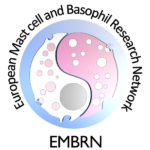Mast cells (MCs) are sentinel cells of the immune system and are found in greater numbers at sites of pathogen exposure such as the skin and
airways. MCs are bestowed with different types of Toll like receptors (TLRs) that are important in the recognition of pathogens (1).Toll-like receptors (TLRs) are a class of proteins that play a key role in both the innate as well as the adaptive immune systems. They are single, membrane spanning, non-catalytic receptors usually expressed in sentinel cells such as mast cells, macrophages and dendritic cells that recognize structurally conserved molecules derived from microbes. TLRs are a type of pattern recognition receptor (PRR) and recognize molecules that are broadly shared by pathogens but distinguishable from host molecules, collectively referred to as pathogen-associated molecular patterns (PAMPs) (2).
TLRs expression among murine and human mast cell subtypes.
Toll-like receptors, the most widely studied PRRs, are characterized structurally by the presence of a leucine rich repeat (LRR) domain in their extracellular domain and a Toll/Interleukin-1 receptor (TIR) domain in their intracellular domain. Activation of TLRs leads to the production of cytokines, chemokines, and antimicrobial peptides and to the up regulation of stimulatory and adhesion molecules involved in immune responses (3). MCs, depending on the subtype and tissue distribution pattern, differentially express TLRs (4). Murine connective tissue type MCs express TLR3, TLR7, and TLR9 mRNA. In contrast, BMMCs only weekly express TLR3, TLR7, and TLR9 mRNA (4). P815 cells (Mouse lymphoblast-like mastocytoma cell line) expresses mRNAs as well as protein of TLR3, TLR7 and TLR9 (5). Another study has examine expression of all the murine TLR mRNAs in connective tissue and mucosal mast cells (6). This study indicate that both subtype of mast cells have high expression of TLR2, 4 and 6. The findings of these studies are summarized in Table 1.
The TLRs also appear to be widely expressed by human mast cells and cell lines. Studies on HCMCs indicate that they express TLR1, TLR2, TLR3, TLR4, TLR6, and TLR8 (7). Human mast cell line LAD2 express TLR1, TLR2, TLR4, TLR5 and TLR 9 at RNA as well as at protein level (8). Human cord blood derived mast cells express (CBMC) express mRNA for a number of TLRs including: TLR1, TLR2, and TLR6 but not TLR4 as checked by RT PCR (9), however cord blood-derived MCs expressed mRNA for TLR2, 4, and 6, whereas TLR expression in Peripheral blood derived MCs is restricted to TLR4 and 6 (10). HMC1 cell express expression of TLR2 as well as TLR4 as confirmed by RT PCR and Western blotting (11). Expression of TLR3, TLR5 and TLR 7 were also observed in HMC1 cell line (7). Skin and lung MC express TLR 2, 3 and 4. Skin mast cells also express TLR9 but little TLR7 or TLR10, while lung mast cells express higher levels of TLR7 and TLR10 but no TLR9 (12).
Table 1 : Expression of TLRs on mast cell
| 1. | Saluja, R., Metz, M., and Maurer, M. (2012) Frontiers in immunology 3, 146 |
| 2. | Novak, N., Bieber, T., and Peng, W. M. (2010) International archives of allergy and immunology 151, 1-7 |
| 3. | Miller, L. S., and Modlin, R. L. (2007) Semin Immunopathol 29, 15-26 |
| 4. | Matsushima, H., Yamada, N., Matsue, H., and Shimada, S. (2004) J Immunol 173, 531-541 |
| 5. | Yang, H., Wei, J., Zhang, H., Lin, L., Zhang, W., and He, S. (2009) BMC cell biology 10, 37 |
| 6. | Saluja, R., Delin, I., Nilsson, G. P., and Adner, M. (2012) PloS one 7, e43547 |
| 7. | Kulka, M., Alexopoulou, L., Flavell, R. A., and Metcalfe, D. D. (2004) The Journal of allergy and clinical immunology 114, 174-182 |
| 8. | Yoshioka, M., Fukuishi, N., Iriguchi, S., Ohsaki, K., Yamanobe, H., Inukai, A., Kurihara, D., Imajo, N., Yasui, Y., Matsui, N., Tsujita, T., Ishii, A., Seya, T., Takahama, M., and Akagi, M. (2007) The Journal of allergy and clinical immunology 120, 452-461 |
| 9. | McCurdy, J. D., Olynych, T. J., Maher, L. H., and Marshall, J. S. (2003) J Immunol 170, 1625-1629 |
| 10. | Inomata, N., Tomita, H., Ikezawa, Z., and Saito, H. (2005) Immunology letters 98, 265-271 |
| 11. | Kubo, Y., Fukuishi, N., Yoshioka, M., Kawasoe, Y., Iriguchi, S., Imajo, N., Yasui, Y., Matsui, N., and Akagi, M. (2007) Inflammation research : official journal of the European Histamine Research Society … [et al.] 56, 70-75 |
| 12. | Kulka, M., and Metcalfe, D. D. (2006) Mol Immunol 43, 1579-1586 |
| 13. | Kawahara, T. (2012) Experimental cell research 318, 2385-2396 |
| 14. | McCurdy, J. D., Lin, T. J., and Marshall, J. S. (2001) J Leukoc Biol 70, 977-984 |
| 15. | Ikeda, T., and Funaba, M. (2003) Immunology letters 88, 21-26 |
| 16. | Mrabet-Dahbi, S., Metz, M., Dudeck, A., Zuberbier, T., and Maurer, M. (2009) Experimental dermatology 18, 437-444 |
| 17. | Supajatura, V., Ushio, H., Nakao, A., Okumura, K., Ra, C., and Ogawa, H. (2001) J Immunol 167, 2250-2256 |
| 18. | Sumbayev, V. V., Yasinska, I., Oniku, A. E., Streatfield, C. L., and Gibbs, B. F. (2012) PloS one 7, e34259 |
Conclusion
Mast cells express different types of TLR receptors that play an important role in instructing the innate and the adaptive immune systems. Mast cells have a significant role in physiological, pathological, as well as in defense mechanisms to fight against pathogens. By understanding the role of TLRs on mast cells may open new perspectives for understanding the role of TLRs / mast cells axis in different allergic diseases associated with mast cells.
References:
| 1. | Saluja, R., Metz, M., and Maurer, M. (2012) Frontiers in immunology 3, 146 |
| 2. | Novak, N., Bieber, T., and Peng, W. M. (2010) International archives of allergy and immunology 151, 1-7 |
| 3. | Miller, L. S., and Modlin, R. L. (2007) Semin Immunopathol 29, 15-26 |
| 4. | Matsushima, H., Yamada, N., Matsue, H., and Shimada, S. (2004) J Immunol 173, 531-541 |
| 5. | Yang, H., Wei, J., Zhang, H., Lin, L., Zhang, W., and He, S. (2009) BMC cell biology 10, 37 |
| 6. | Saluja, R., Delin, I., Nilsson, G. P., and Adner, M. (2012) PloS one 7, e43547 |
| 7. | Kulka, M., Alexopoulou, L., Flavell, R. A., and Metcalfe, D. D. (2004) The Journal of allergy and clinical immunology 114, 174-182 |
| 8. | Yoshioka, M., Fukuishi, N., Iriguchi, S., Ohsaki, K., Yamanobe, H., Inukai, A., Kurihara, D., Imajo, N., Yasui, Y., Matsui, N., Tsujita, T., Ishii, A., Seya, T., Takahama, M., and Akagi, M. (2007) The Journal of allergy and clinical immunology 120, 452-461 |
| 9. | McCurdy, J. D., Olynych, T. J., Maher, L. H., and Marshall, J. S. (2003) J Immunol 170, 1625-1629 |
| 10. | Inomata, N., Tomita, H., Ikezawa, Z., and Saito, H. (2005) Immunology letters 98, 265-271 |
| 11. | Kubo, Y., Fukuishi, N., Yoshioka, M., Kawasoe, Y., Iriguchi, S., Imajo, N., Yasui, Y., Matsui, N., and Akagi, M. (2007) Inflammation research : official journal of the European Histamine Research Society … [et al.] 56, 70-75 |
| 12. | Kulka, M., and Metcalfe, D. D. (2006) Mol Immunol 43, 1579-1586 |
| 13. | Kawahara, T. (2012) Experimental cell research 318, 2385-2396 |
| 14. | McCurdy, J. D., Lin, T. J., and Marshall, J. S. (2001) J Leukoc Biol 70, 977-984 |
| 15. | Ikeda, T., and Funaba, M. (2003) Immunology letters 88, 21-26 |
| 16. | Mrabet-Dahbi, S., Metz, M., Dudeck, A., Zuberbier, T., and Maurer, M. (2009) Experimental dermatology 18, 437-444 |
| 17. | Supajatura, V., Ushio, H., Nakao, A., Okumura, K., Ra, C., and Ogawa, H. (2001) J Immunol 167, 2250-2256 |
| 18. | Sumbayev, V. V., Yasinska, I., Oniku, A. E., Streatfield, C. L., and Gibbs, B. F. (2012) PloS one 7, e34259 |
Abbreviations:
BMMC= Bone marrow-derived mast cell, FSMC= Fetal skin-derived cultured mast cell
CTLMC= Connective tissue-like mast cells, MLMC = Mucosal like mast cell
HCMC= Human cultured mast cell, CBMC=Cord blood derived mast cells
HMC-1= Human mast cell line-1, PBMC= Peripheral blood derived mast cell

